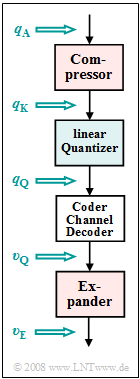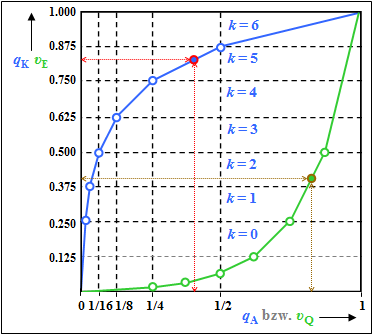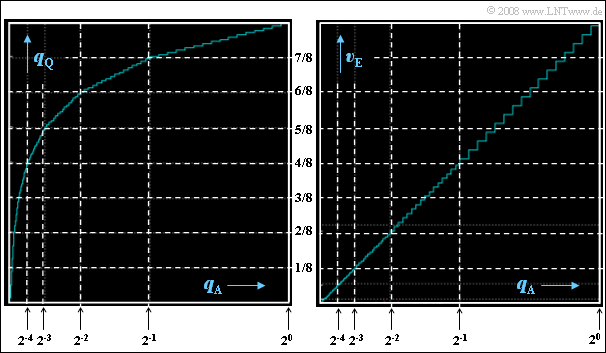Difference between revisions of "Aufgaben:Exercise 4.5: Non-Linear Quantization"
| Line 1: | Line 1: | ||
| − | {{quiz-Header|Buchseite= | + | {{quiz-Header|Buchseite=Modulation_Methods/Pulse_Code_Modulation |
}} | }} | ||
Revision as of 15:43, 7 April 2022
To investigate nonlinear quantization we start from the outlined system model.
- We disregard the influence of the channel and the PCM coding or decoding.
- Thus, $v_{\rm Q}(ν \cdot T_{\rm A}) = q_{\rm Q}(ν \cdot T_{\rm A})$ always applies, whereby the time specification $ν \cdot T_{\rm A}$ is omitted in the following.
By comparing one output variable with one input variable at a time, it is possible to determine the influence
- of the compressor ⇒ $q_{\rm K}(q_{\rm A})$,
- of the linear quantizer ⇒ $q_{\rm Q}(q_{\rm K})$,
- of the nonlinear quantizer ⇒ $q_{\rm Q}(q_{\rm A})$,
- of the expander ⇒ $v_{\rm E}(v_{\rm Q})$, and
- of the overall system ⇒ $v_{\rm E}(q_{\rm A})$
The following assumptions are made:
- All samples $q_{\rm A}$ are in the range of values $±1$ .
- The (linear) quantizer works with $M = 256$ quantization levels, which are marked with $μ = 0$ to $μ = 255$ .
- For compression, the so-called 13-segment characteristic is used.
This means:
- In the range $|q_{\rm A}| ≤ 1/64$ holds $q_{\rm K} = q_{\rm A}$.
- For $q_{\rm A} > 1/64$ , $k = 1$, ... , $6$ the following six additional ranges of the compressor characteristic:
- $$q_{\rm K}(q_{\rm A}) = 2^{4-k} \cdot q_{\rm A} + {k}/{8}\hspace{0.9cm} {\rm im\,\,range}\hspace{0.9cm}2^{k-7}< q_{\rm A} \le 2^{k-6} \hspace{0.05cm}.$$
- Another six domains exist for the negative $q_{\rm A}$ values with $k = -1$, ... , $-6$, which are point-symmetric with respect to the origin.
- However, these are not considered further in this exercise.
Hints:
- The task belongs to the chapter Pulse code modulation.
- Reference is made in particular to the page Compression and Expansion.
Questions
Solution
- $$q_{\rm K}(q_{\rm A}) = 2^{4-k} \cdot q_{\rm A} + {k}/{8}={1}/{2}\cdot 0.4 + {5}/{8} \hspace{0.15cm}\underline {= 0.825}\hspace{0.05cm}.$$
(2) The input value of the linear quantizer is now $q_{\rm K} = 0.825$, so the following calculation applies:
- $${105}/{128} < q_{\rm K} = 0.825 \le {106}/{128}\hspace{0.3cm}\Rightarrow \hspace{0.3cm} m = 105 \hspace{0.3cm}\Rightarrow \hspace{0.3cm} \mu = 128 + 105\hspace{0.15cm}\underline { = 233} \hspace{0.05cm}.$$
(3) According to the specification page, the quantization interval $μ = 128 + m$ is given by the value $q_{\rm Q} = 1/256 + m/128$ represented. With $m = 105$ it follows:
- $$q_{\rm Q} = \frac{1}{256} + \frac{105}{128} \hspace{0.15cm}\underline {\approx 0.824} \hspace{0.05cm}.$$
(4) According to the sample solution to the subtask (3) with the input value $q_{\rm A} = 0.04$:
- $$ \frac{1}{32} < q_{\rm A} \frac{1}{16}\hspace{0.3cm}\Rightarrow \hspace{0.3cm} k = 2 \hspace{0.3cm}\Rightarrow \hspace{0.3cm} q_{\rm K} = 2^2 \cdot 0.04 + \frac{2}{8}= 0.41$$
- $$\Rightarrow \hspace{0.3cm}\frac{52}{128} < q_{\rm K} = 0.41 \le \frac{53}{128}\hspace{0.3cm}\Rightarrow \hspace{0.3cm} m = 52 \hspace{0.3cm}\Rightarrow \hspace{0.3cm} \mu = 128 + 52 = 180\hspace{0.3cm} \Rightarrow \hspace{0.3cm}q_{\rm Q} = \frac{1}{256} + \frac{52}{128} \hspace{0.15cm}\underline {= 0.41} \hspace{0.05cm}.$$
(5) We are looking for the solution in several steps:
- In the compressor has $q_{\rm A} = 0.4$ led to the initial value $q_{\rm K} = 0.825$ and after quantization to the value $q_{\rm Q} = 0. 824$– see subtasks (1) and (3). Note the red marks in the graph.
- The graph shows that, on the receiver side, this results in $v_{\rm Q} = 0.824$ approximately back to $v_{\rm E} ≈ 0.4$ ⇒ brown marks in the graph.
However, due to quantization, this is only an approximation. Exactly:
- $$ v_{\rm E} = 0.25 + \frac{0.824-0.750}{0.875-0.750} \cdot 0.25 \hspace{0.15cm}\underline {= 0.398} \hspace{0.05cm}.$$
This calculation process can be understood from the graph. Although the expander characteristic $v_E(υ_{\rm Q})$ is equal to the inverse function of the compressor characteristic $q_K(q_{\rm A})$ an error results because the input $v_{\rm Q}$ of the expander is discrete in value (influence of quantization).
(6) Correct are statements 1 and 4, as can be verified by the following left graph:
- The width of each step is different in each segment.
- In the outermost segment $(k = 6)$ the step width is $0.5/16 = 1/32$, in the next segment $(k = 5)$ only more $0.25/16 = 1/64$.
- The step widths in the further segments are $1/128 \ (k = 4)$, $1/256 \ (k = 3)$, $1/512\ (k = 2)$ and $1/1024 \ (k = 1)$.
- The innermost range from $-1/64$ to $+1/64$ is divided into $64$ steps, resulting in the step width $1/2048$ .
- The step height, on the other hand, is constantly equal $1/8$ divided by $16 = 1/128$ in the segments $k ≠ 0$ and equal $1/256$ in the middle segment.
(7) Correct here is only the second statement:
- By the expander, the quantization is now along the bisector of the angle.
- In each segment, step width and step height are constant.
- As the right graphic shows, however, in the next inner segment the width and the height are only half as large.


